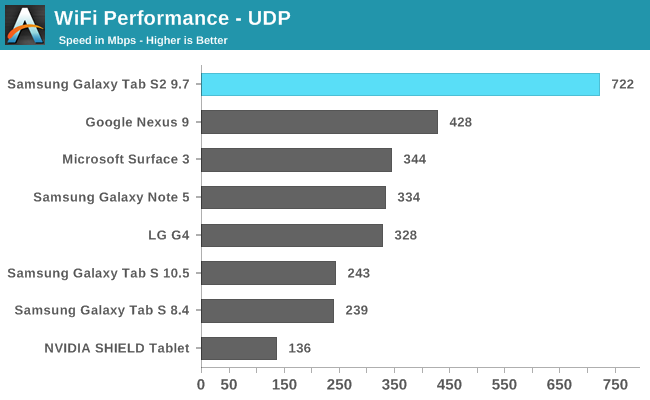The Samsung Galaxy Tab S2 Review
by Brandon Chester on October 15, 2015 8:00 AM ESTCamera: Photos and Videos
The number of users that use their tablet as their primary camera is far larger than anyone ever could have predicted when the tablet market was emerging. However, there are some obvious reasons why someone would opt for their tablet. It may actually be the best camera they own, and older users with aging eyes can definitely appreciate the fact that their tablet display turns into a giant high resolution viewfinder. The cameras themselves have also improved significantly from the dark days of the 1.2MP rear camera on the iPad 2.
Since the Tab S2 is extremely thin, Samsung has needed to allow for a camera hump in order to fit their 8MP sensor. The hump isn't very large, and although it's larger than that of the iPhone 6, it's not near as large as the camera hump on the Galaxy S6. It's honestly not really an issue, but some customers who are very serious about the design of their devices may take issue with it.
Below you can view the known specifications of the Tab S2's rear and front-facing cameras. Unfortunately I don't have data on the specific model of the rear-facing sensors used in the original Tab S series, so that info is omitted on the chart.
| Camera Specifications | ||||
| Galaxy Tab S1 Series | Galaxy Tab S2 Series | |||
| Front Camera | 2.1MP (1920x1080) |
|||
| Front Camera - Sensor | S5K6B2 (1.34 µm, 1/6") |
|||
| Front Camera - Focal Length | N/A | 27mm eff | ||
| Front Camera - Max Aperture | F/2.4 | F/2.2 | ||
| Rear Camera | 8.0MP (3264x2448) |
|||
| Rear Camera - Sensor | N/A (1.12 µm, 1/4") |
S5K4H5 (1.12 µm, 1/4") |
||
| Rear Camera - Focal Length | 32mm eff | 31mm eff | ||
| Rear Camera - Max Aperture | F/2.4 | F/1.9 | ||
While Samsung hasn't made any radical changes to the camera sensor specifications with the Tab S2, they have significantly widened the rear-facing camera's aperture. Changes to image processing and ISP improvements will also have an enormous impact on image quality.
As always, my photo testing begins with a scene during the day, followed by that same scene at night to test low light performance. While the low light test is still pretty brutal on current tablets, it's a very good indicator of the quality of an OEM's image processing.
During the day the Tab S2 performs very well. Detail is on par with the iPad Air 2, which isn't surprising given the similar sensors and Samsung's large improvements in image processing quality this year. My only complaint is that there is a bit too much sharpening going on which exacerbates the artifacting on the wall of the building caused by the limited effective resolution of the camera system. What's interesting is that the Galaxy S6 Edge processes the image with less sharpening, which is likely intentional on Samsung's part as the S6 has a much larger sensor with a higher resolution. Overall, I'm happy with the Tab S2's camera quality, and I'm glad Samsung decided to give the tablet a bit of a camera hump instead of crippling the camera quality to fit in the 5.6mm profile of the chassis.
Low light photography is where I started to have some issues taking photos with the Tab S2. For some reason it simply refused to run the autofocus, and I had to try and manually focus by tapping which is difficult on such a large device. Once I was able to focus and take the shot I took a few, and the best result is the one you see above. For a tablet it's actually a pretty good photo, although as you can see from the street lamps the photo is definitely overexposed to a degree. Compared with the iPad Air 2 there's actually not much more visible in the frame despite the overexposure, and the Air 2 has a better rendition of the grassy patch on the right side as well as the no parking sign. Both photos are still very good as far as tablets go, but I do think the iPad wins out by a little bit because of the exposure and slightly better detail preservation.
The Tab S2 can record video at 1080p30, and also at 1440p30 although the latter disables video stabilization and so I've opted to just use the 1080p recording mode. Looking back at all the tablets I've evaluated, it's clear that the Tab S2 has the best video recording quality by far. It's definitely not perfect, with some jiggle to the frames caused by the EIS and a bit too much saturation to the colors, but the overall quality, sharpness, and consistency of the frame rate is better than any other device I've tested.
WiFi Performance
Like the original Tab S, the Tab S2 ships with a 2x2 802.11ac WiFi implementation. I actually haven't been able to track down exactly which WiFi chipset they're using, which is unfortunate. The original Tab S actually had strangely slow WiFi performance given its peak theoretical bandwidth of 866Mbps, and I was hopeful that the Tab S2 would fare better.

As you can see, the WiFi performance on the Tab S2 is miles ahead of the previous models, and ends up having the highest peak bandwidth on record for a mobile device. Samsung did a great job improving on last year's WiFi implementation, and if there's going to be any bottleneck over WiFi it's not likely that t it will be the Tab S2.























162 Comments
View All Comments
osxandwindows - Thursday, October 15, 2015 - link
@FlyBriWhat if you could get an iPad screen on an iPhone?
lilmoe - Thursday, October 15, 2015 - link
You have all the right to disagree. These are only opinions, Yours and mine. These opinions might be very different from Samsung's research and design decisions. I've simply stated a *possibility* for their alleged "compromise(s)". Who knows, Samsung probably decided to skip the 7420 because of low yield, and they prioritized their flagship smartphones over their tablets.That said, liking the iPad's LCD has nothing to do with the price difference. AMOLED is still more expensive to manufacture. I would argue that OLED is generally more appealing to consumers and more pleasing to the eyes. Samsung's AMOLED has drastically improved the past couple of years. According to my own experience, people just love the "pop"... And those who prefer color accuracy are also well served by the current generation of AMOLED.
ARM tablets are no longer the mainstream "must haves". Most people don't even use them anymore. Samsung, Apple and other manufacturers are researching the needs for specific niche consumers at this point.
For those who do, I really hardly see anyone using an ARM tablet outside of social media, browsing, watching video. Maybe a magazine here and there, but nothing else. I completely disagree that tablet users who play high-end games are any sort of majority. High end, or AAA, gaming is usually exclusive for consoles and PCs. Most tablet users play less resource intensive, casual games. Besides, there aren't even that many titles (if any) in the Play Store than can saturate the Exynos 5433, let alone Apple's A8X (most tablets sold are NOT iPad Air 2s... and game developers target lower specs for iOS). The Exynos 5433 is more than capable of running titles like Asphalt 8 and Dead Trigger just fine.
Also, tablets are used a LOT less than smartphones. Therefore, one might argue that longer battery life isn't as important as thinner, lighter profiles for current tablet consumers.
nerd1 - Thursday, October 15, 2015 - link
Check BOM of iPhones and galaxy phones. AMOLED screen are usually 3x the price of LCDs.And what can you do with that 'powerful' AP anyway? Running dumbed down mobile browser? Running crappy phone games? Playing 8K video on 2K screen?
zepi - Thursday, October 15, 2015 - link
Tablets are an odd market. People mostly seem to use them for web browsing and video viewing, where performance doesn't really matter that much. Reason is unknown. Maybe it is the matter of apps not existing for other tasks. Or maybe tablet form factor just doesn't work with anything else.I guess that mostly because of this, Android makers try to get away with putting cheap and "slow" SOC's into their tablets.
Apple hit the same issue when it was noticed that iPad sales was way slower than expected. It seems that upgrade cycles are much longer, since simple performance bumps just didn't seem to matter and there are no 24month phone-contracts like with the phones to push sales. This has obviously led to Apple's current push towards trying to transform tablet market by making iPad Air 2 & iPad Pro and putting emphasis behind the productivity use with the hopes of pushing the market towards something more than just content consumption.
MS seems to be pushing for the same thing with Surfaces, though they are coming from the desktop direction when Apple is approaching this market from mobile device direction.
Android makers... Well, as can be seen here, Samsung can only do so much with the multitasking and productivity features and Google has been quite ignorant towards pushing tablets forwards.
FlyBri - Thursday, October 15, 2015 - link
@zepi I would agree that most people use tablets for web browsing and video (probably more so for web browsing), which is why Samsung went with a 4:3 aspect ratio on the Tab S2. Since they did that, they lost their differentiating factor with the iPad. Because of this, they really needed to step it up to compete, and they pretty much failed on that front. The Tab S2 is significantly slower and gets much worse web browsing battery life than the Air 2, and the Air 2 is a year old. I have no problem with Samsung releasing the Tab S2, but it's very clear it's overpriced. For what it is and what it can do, it's a $300-350 tablet in today's market, not $500.osxandwindows - Thursday, October 15, 2015 - link
You can't really use surface touch screen for productivity, There is simply no windows productivity apps for tablet.The iPad pro is not going to fail like most people say.
The iPad pro has one advantage over the surface and that is the App Store.
zepi - Thursday, October 15, 2015 - link
It remains to be seen. Personally my guess is that both will have their supporters and both will "stay alive".osxandwindows - Thursday, October 15, 2015 - link
@zepiIts not that I don't like the concept behind the surface pro or surface book.
Its just that I don't see the use of a touch screen that can be removed.
Media consumption?, with 3 hours of battery life when removed?, I wood rather buy an iPad for that.
blackcrayon - Thursday, October 15, 2015 - link
Yeah at that point, why not have a nice laptop and a decent tablet on the side, you can even use them together for some tasks.osxandwindows - Thursday, October 15, 2015 - link
If you have a mac and an iPad pro, You will have the perfect combination.Apples continuity is pretty much like a surface use case.
Plus with lightning flash drives you will be able to save 4k video.